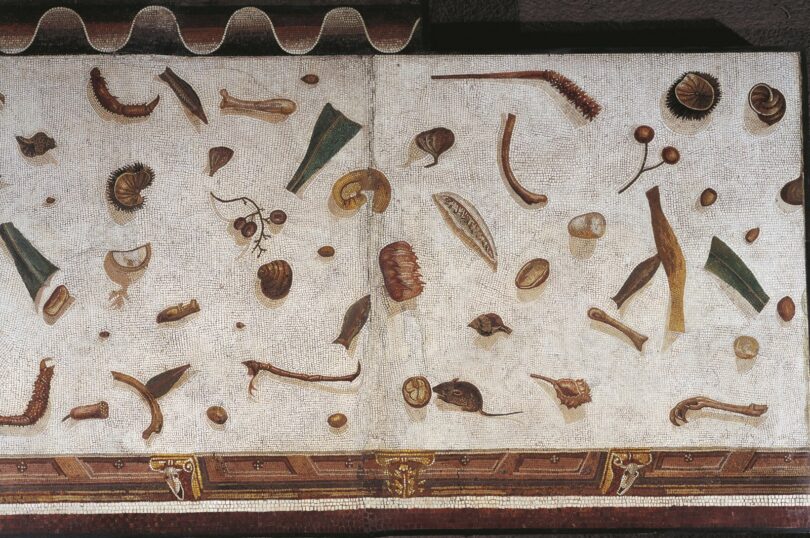VATICAN : In the Vatican’s Profane Museum, amid the ornate sarcophagi and marble statues, lies an artifact that seems oddly out of place: a mosaic floor that appears to be littered with the remnants of a meal.
At first glance, it looks like kitchen refuse scattered across the floor – nutshells, olive pits, fruit rinds and grape stems. However, upon closer inspection, these food scraps reveal themselves to be intricately crafted pieces of stone and glass. This trompe l’oeil mosaic is exceptionally detailed, with gleaming shells, spiny chestnut husks and grapes covered in a soft, velvety bloom.
Such mosaics once adorned the triclinia, or dining rooms, of ancient Rome, where guests reclined on couches, savoring various delicacies. This particular mosaic was discovered in the ruins of a villa on Aventine Hill and still exudes the atmosphere of those lavish Roman feasts. The scattered food casts long, irregular shadows as if illuminated by flickering oil lamps, and even a small mouse in the corner, nibbling on a nut, has a glimmer of lamplight in its eye.
This mosaic motif, known as “asarotos oikos” or “unswept room” in Greek, was popular enough to have its own name. Although Greek artists created these mosaics, the versions we have today are Roman copies made during a period of intense admiration for Greek culture. But why would wealthy Romans go to such lengths and expense to decorate their dining room floors to resemble trash-strewn surfaces?
Firstly, it served as a clever status symbol. The refuse depicted in the mosaic from the Profane Museum represents luxury trash. It includes fresh seafood like lobster and oysters, the spiny shell of a Murex Brandaris (the source of the elite Tyrian purple dye) and exotic imports such as mulberries from Asia, ginger from India and figs from the Middle East. The mosaic portrays the wealth and reach of the Roman Empire, scattered casually on the floor.
The “unswept room” motif is often paired with designs of theatrical masks and central scenes from the Nile. Additionally, the mosaic suggests a feast so opulent that it could have violated Roman sumptuary laws, which restricted how much a host could spend on a banquet. The Lex Orchia of 182 B.C. limited the number of guests at a meal, and later laws banned the consumption of luxurious items like fattened fowl, shellfish and sow’s udders. However, historical accounts suggest these laws were frequently ignored, as hosts sought to impress their guests by flaunting these restrictions.
Art historians also link this motif to the Roman tradition of “memento mori,” or reminders of death. Such references to mortality were common at Roman banquets. For example, little jointed bronze skeletons called larva convivalis were used as party entertainment, as seen in the Satyricon, where one skeleton dances on a table while the host reminds the guests of their mortality. The mosaic, therefore, serves as a reminder that even the finest feast quickly turns to refuse, just as diners themselves will eventually become bones and dust. It urges guests to enjoy their meal, as it might be their last.
Nearly 2,000 years separate us from those who once dined over this mosaic. While the imagined deaths of those diners have long since occurred, their “trash” remains preserved in this artistic illusion. James Davidson, a professor of ancient history, notes in his book “Courtesans and Fishcakes” that some of the food remnants in the mosaic don’t quite meet their own shadows, suggesting they are still in the process of falling. This detail adds a sense of continuity, implying that although the diners are long gone, the feast continues.







